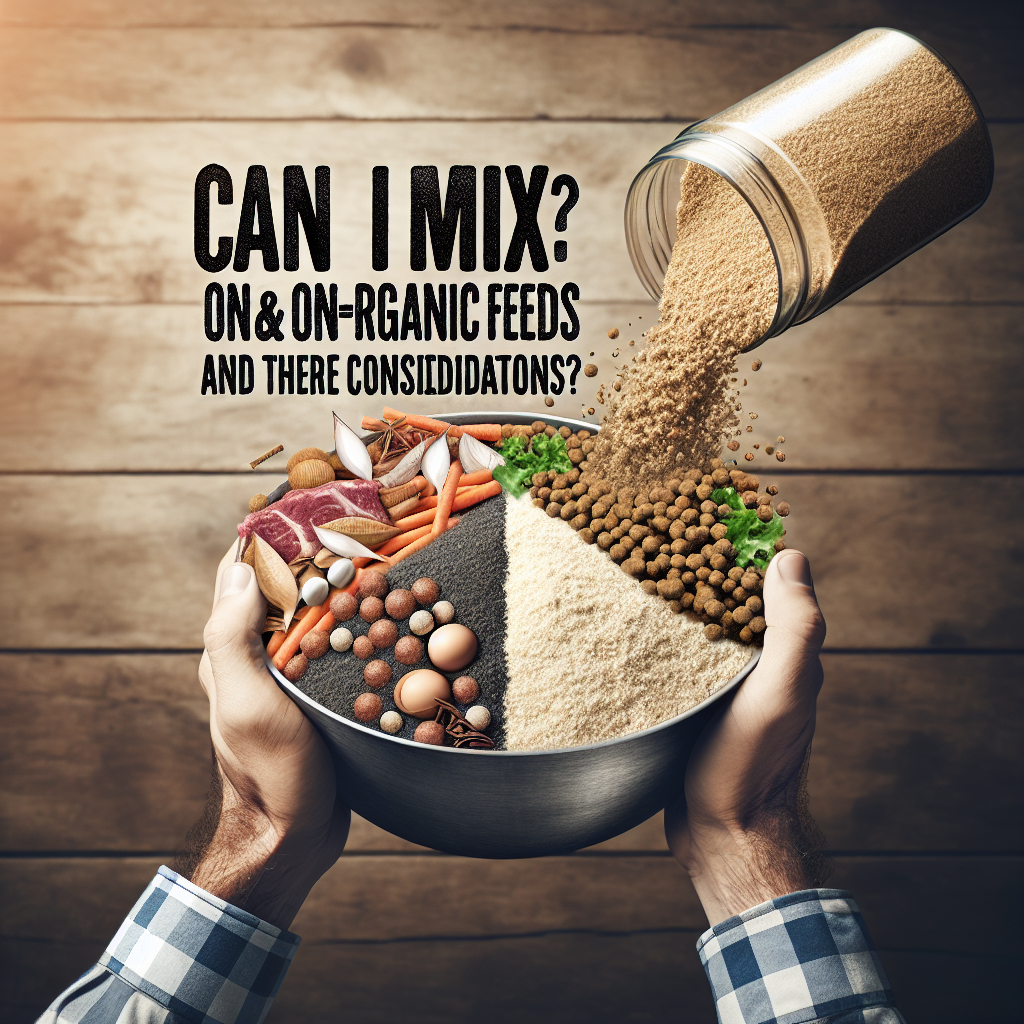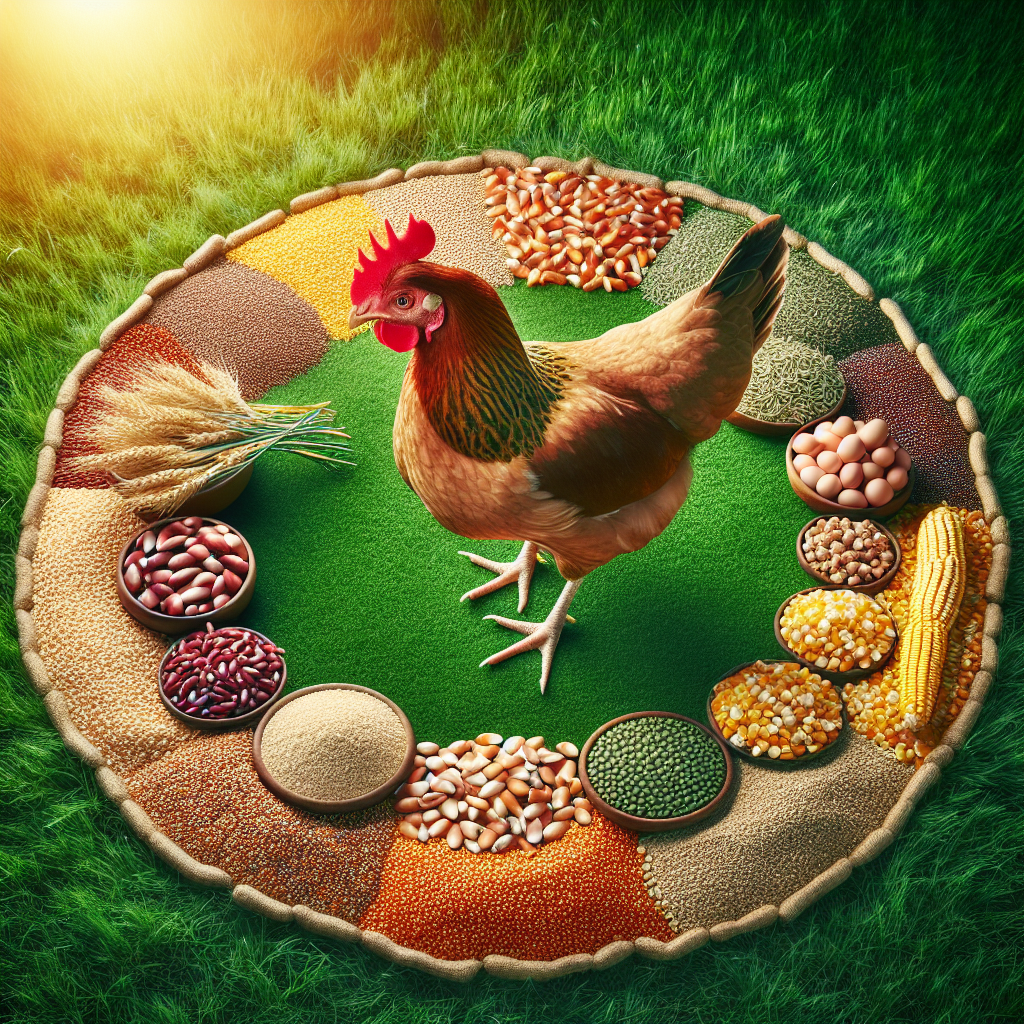Have you ever wondered if it’s possible to mix organic and non-organic feeds for your animals? Well, the short answer is yes, you can. However, there are a few important considerations to keep in mind. Not only do you need to ensure the safety and health of your animals, but you also need to meet the regulations and standards set by organic certification bodies. So, let’s take a closer look at the potential impacts and factors to consider when mixing organic and non-organic feeds for your beloved animals.
Benefits of Organic Feed
Higher nutrient content
Organic feed is known to have higher nutrient content compared to non-organic feed. This is because organic farming practices prioritize soil health and utilize natural fertilizers, leading to richer soil and better nutrient absorption by plants. As a result, organic feed contains higher levels of essential vitamins, minerals, and antioxidants, which are beneficial not only for the animals consuming it but also for the consumers of animal products.
Free from harmful chemicals
One of the major advantages of organic feed is that it is free from harmful chemicals such as synthetic pesticides, herbicides, and fertilizers. Non-organic feed often contains residues of these chemicals, which can be detrimental to both the animals and the environment. By opting for organic feed, you can ensure that the animals are not exposed to these harmful substances, which can have long-term effects on their health and the quality of the products they provide.
Promotes animal welfare
Organic feed is produced with a strong emphasis on animal welfare. Organic farming practices prioritize providing animals with access to natural environments and outdoor spaces, ensuring their freedom to roam and engage in natural behaviors. Additionally, organic feed is sourced from farmers who adhere to strict animal welfare standards, such as ensuring adequate space, good ventilation, and a balanced diet. By choosing organic feed, you are actively supporting ethical and humane treatment of animals.
Potential Risks of Non-Organic Feed
Exposure to pesticide residues
One of the primary risks associated with non-organic feed is the exposure to pesticide residues. Conventionally produced crops, which are often used in non-organic feed, are frequently sprayed with synthetic pesticides. These pesticides can make their way into the animal feed and accumulate in their bodies over time. Continuous exposure to these pesticide residues can have detrimental effects on animal health and potentially transfer to humans through the consumption of animal products.
Potential antibiotic resistance
Non-organic feed commonly contains antibiotics, which are used as growth promoters and to prevent diseases in animals. However, the overuse of antibiotics in animal farming has raised concerns about the development of antibiotic-resistant bacteria. This could have serious implications for both animal and human health. Antibiotic resistance can render antibiotics ineffective in treating certain diseases, making it crucial to limit the use of antibiotics in animal feed.
Lower nutritional value
Non-organic feed may have lower nutritional value compared to organic feed due to the use of synthetic fertilizers and farming practices that prioritize quantity over quality. Synthetic fertilizers often focus on providing macronutrients without taking into account the full range of essential micronutrients needed for optimal animal health. As a result, animals consuming non-organic feed may be deficient in certain key nutrients, which can impair their growth, development, and overall well-being.
Mixing Organic and Non-Organic Feed
Feeding strategies
If you decide to mix organic and non-organic feed, it is important to have a clear feeding strategy in place. This strategy should outline the ratio of organic to non-organic feed and ensure that the nutritional requirements of the animals are met. It is advisable to consult with a veterinarian or a nutritionist specializing in organic farming to develop a feeding plan that takes into account the specific needs of your animals.
Gradual transition
When transitioning from non-organic to organic feed, it is recommended to do so gradually. Abrupt changes in diet can cause digestive upset and stress in animals. Start by introducing small amounts of organic feed while gradually reducing the amount of non-organic feed. This gradual transition allows the animals to adapt to the new feed and minimizes the risk of digestive disturbances.
Monitoring animal health
Regular monitoring of animal health is essential when mixing organic and non-organic feed. Keep a close eye on the animals’ overall well-being, growth rate, and any signs of digestive issues. In case of any concerns or health issues, it is important to consult with a veterinarian, who can provide guidance on adjusting the feed mixture or addressing any potential health problems that may arise.
Certification and Labeling
Labeling regulations
Certified organic feed must adhere to specific labeling regulations. This ensures that consumers can make informed choices about the products they purchase. Labels on organic feed should clearly state the organic certification logo, the percentage of organic ingredients, and any additional certifications or standards met by the feed. Familiarize yourself with the labeling regulations in your region to ensure that you are purchasing and using certified organic feed.
Certification bodies
Various certification bodies exist that verify and certify organic feed. These organizations set standards and guidelines that organic feed producers must follow to obtain certification. Examples include the USDA Organic certification in the United States and the European Union Organic Farming logo. When sourcing organic feed, look for products that carry the certification logo from reputable certification bodies to ensure that the feed meets the required organic standards.
Keeping track of feed composition
Maintaining accurate records of the composition of organic and non-organic feed used is crucial for compliance with organic certification requirements. This includes keeping track of the types and percentages of organic and non-organic ingredients used in the feed mixture. Additionally, records should include information on suppliers, batch numbers, and any testing or certification documents obtained. These records serve as documentation for inspections and audits conducted by certification bodies.
Traceability and Contamination Risks
Tracing organic and non-organic ingredients
Tracing the origin of both organic and non-organic ingredients used in feed production is essential for ensuring transparency and preventing contamination risks. Establish a system to trace the sources of all ingredients and maintain records of suppliers and their organic certification status. This enables you to verify the authenticity of organic feed ingredients and identify any potential contamination risks.
Contamination prevention measures
To minimize the risk of contamination, it is important to implement proper storage and handling procedures for organic and non-organic feed. Store them separately to prevent cross-contamination and ensure that the storage areas are clean, dry, and properly sealed. Regularly inspect the storage areas for any signs of pests or other sources of contamination. It is also advisable to establish protocols for cleaning equipment and feeders between different types of feed to avoid unintentional mixing.
Testing for contaminants
Regular testing for contaminants is crucial when mixing organic and non-organic feed. This includes testing for pesticide residues, heavy metals, and other potential contaminants that may be present in non-organic ingredients. By conducting regular tests, you can ensure that the feed meets the required safety standards and minimize the risk of exposing animals and consumers to harmful substances.
Economic Considerations
Price differential
One of the factors to consider when mixing organic and non-organic feed is the price differential between the two types. Organic feed generally comes at a higher cost compared to non-organic feed due to the additional expenses associated with organic certification and organic farming practices. It is important to factor in the price differential and assess whether the potential benefits of mixing outweigh the higher cost of organic feed.
Cost-benefit analysis
Conducting a cost-benefit analysis can help determine the potential economic impact of mixing organic and non-organic feed. Consider factors such as animal health, productivity, and the market demand for organic products. Assess whether the benefits in terms of improved animal welfare, product quality, and consumer perception outweigh the costs associated with using organic feed. This analysis will help you make an informed decision based on your specific circumstances.
Long-term investment
Mixing organic and non-organic feed can be seen as a long-term investment in the overall sustainability and success of your farming operation. It allows you to gradually transition towards more sustainable and environmentally-friendly practices while meeting consumer demand for organic products. Consider the potential long-term benefits of mixing feeds, such as improved soil health, reduced environmental impact, and enhanced reputation as a sustainable producer.
Environmental Impact
Pesticide runoff
One of the environmental impacts associated with non-organic feed production is pesticide runoff. Synthetic pesticides used in conventional farming can leach into the soil and water, contaminating nearby ecosystems. By choosing organic feed, you contribute to reducing pesticide runoff and its detrimental effects on soil and water quality. Organic farming practices focus on using natural methods to control pests and emphasize soil conservation, thereby minimizing the negative impact on the environment.
Soil and water quality
Organic feed production plays a crucial role in preserving soil and water quality. Organic farming practices prioritize the use of organic fertilizers, crop rotation, and cover crops to promote soil health and fertility. This leads to increased organic matter content, improved water retention, and reduced erosion. By opting for organic feed, you support sustainable farming practices that help maintain healthy soil and safeguard the quality of local water sources.
Sustainable farming practices
Choosing organic feed aligns with sustainable farming practices that aim to minimize the environmental impact of agricultural activities. Organic farmers prioritize biodiversity by promoting the use of natural habitats, conserving water resources, and reducing reliance on synthetic inputs. By using organic feed, you contribute to the overall sustainability of the farming industry by reducing chemical pollution, preserving ecosystems, and supporting the long-term health of the planet.
Animal Health and Product Quality
Impact on growth and development
Feeding animals with organic feed can have positive effects on their growth and development. Organic feed is rich in essential nutrients and supports the animal’s overall health and well-being. By providing animals with feed that is free from harmful chemicals and higher in nutritional value, you contribute to their optimal growth and development. This, in turn, can lead to healthier and more productive animals.
Quality of meat, milk, or eggs
The quality of meat, milk, or eggs produced by animals fed with organic feed is often considered superior compared to those from animals fed with non-organic feed. Organic feed, being free from synthetic additives and sourced from high-quality ingredients, can result in products that are more flavorful, nutritious, and free from chemical residues. Consumers increasingly value the superior quality and taste of organic animal products, making it a desirable choice for farmers.
Consumer perception
Consumer perception plays a significant role in the market demand for organic animal products. Many consumers are becoming more conscious of the food they consume and prioritize products that are produced in an ethical and sustainable manner. By using organic feed, you align with consumer preferences and enhance your reputation as a producer committed to animal welfare, environmental sustainability, and quality. This can translate into an increased market demand and the potential for higher prices for your products.
Legal and Regulatory Compliance
Complying with organic standards
When mixing organic and non-organic feed, it is important to comply with organic standards and regulations. Organic standards define the specific requirements that must be met to obtain organic certification for both feed production and animal farming. Ensure that the feed you mix aligns with the organic standards set by certification bodies in your region. Non-compliance with organic standards can have legal implications and may result in a loss of organic certification.
Government regulations and inspections
Government regulations govern the production and sale of organic feed. Depending on your location, there may be specific regulations in place that dictate the production, labeling, and marketing of organic feed. Regular inspections may be conducted by government agencies or certification bodies to ensure compliance with these regulations. Familiarize yourself with the applicable regulations and prepare for inspections to maintain legal compliance and organic certification status.
Legal implications of mixing feeds
Mixing organic and non-organic feed may have legal implications. Ensure that you are aware of any legal restrictions or requirements associated with mixing feeds in your region. Some organic certifications may prohibit the use of non-organic feed altogether, while others may have specific guidelines regarding the proportion of organic and non-organic ingredients that can be used. Adhering to these legal requirements is crucial to avoid potential penalties and maintain the integrity of organic certification.




